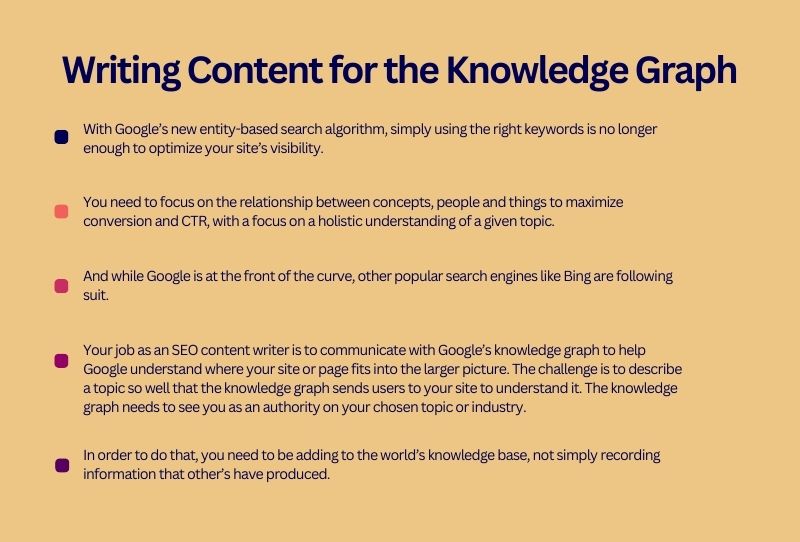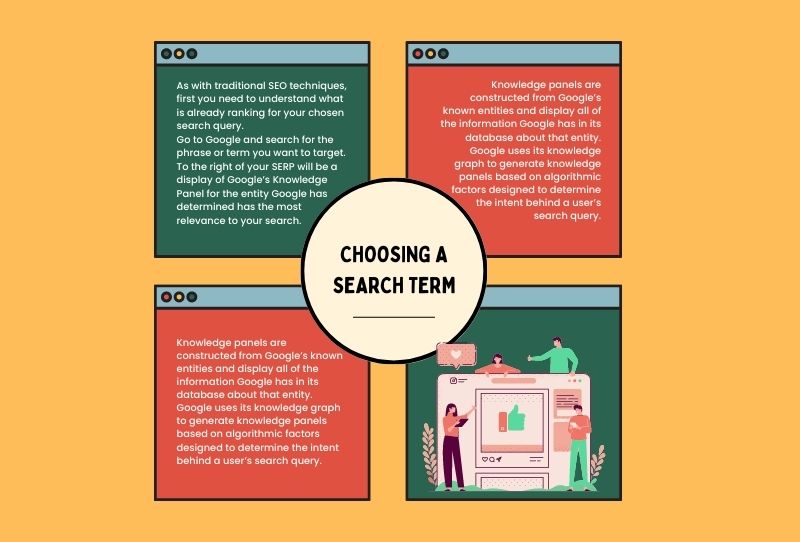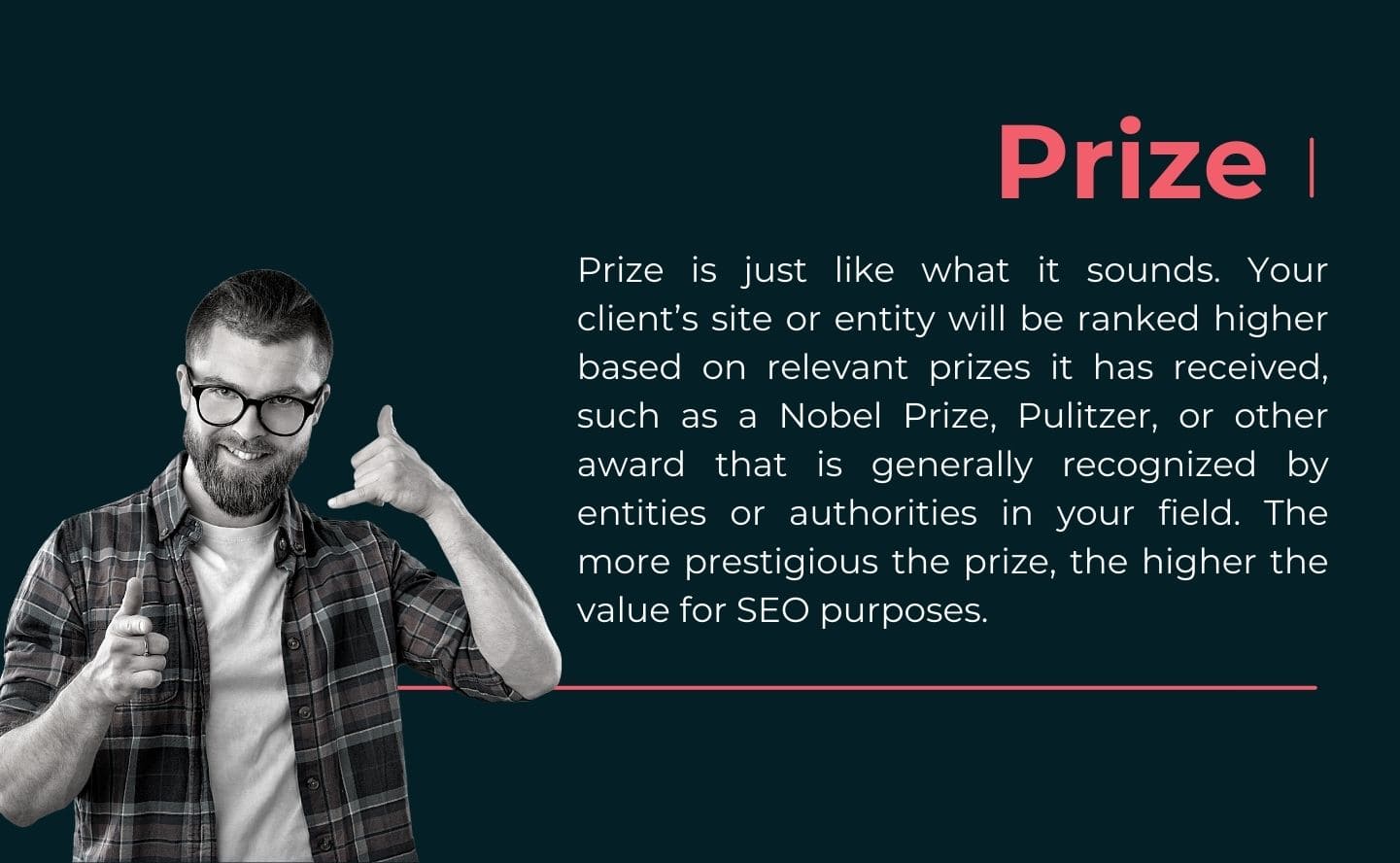Entity SEO

How to Write Competitive Content for Entity SEO
If you’ve been paying any attention to trends in modern SEO, you probably know that recent changes to Google’s ranking algorithms have shifted the focus of search engine optimization from ‘keywords’ to ‘entities’.
There are a lot of good resources out there that attempt to explain the concept of the ‘entity’ and how exactly Google’s shift of focus works at a macro-level.
In this article, I want to discuss a more practical question for modern agencies and SEO experts: How do you actually write content to maximize search rankings and traffic in the new world of entity SEO?
But first, let’s examine a quick overview of what exactly entity SEO is, how it works, and what it means for the future of SEO.


What is Entity SEO, Exactly?
Traditional SEO focuses on keywords and the user intent behind the keywords they use.
With the shift toward entities, Google has readjusted their search algorithm to focus less on keywords (though keywords still matter, as you will see below) and instead focus on the concept of ‘entities’.
What is an entity?
Google defines an entity as anything that is “singular, unique, well-defined, and distinguishable.”
An entity does not need to be a physical thing or tangible object. It can be a noun, person, color, event, date, currency, word, or even a concept or idea. Basically, any well-defined and distinguishable topic can be an entity.
A good way to think about entities is that anything that has its own Wikipedia page can be an entity.
In fact, Google uses Wikipedia as one of the sources for its entity database.
So, for example, an entity could be a well known person, a brand like Nike or Apple, a popular piece of music, a language, the concept of democracy or authoritarianism, a type of business or service, or even the concept of entity SEO itself.
If you can identify something as a distinguishable and well-defined topic, it is an entity.
The Knowledge Graph and Google’s Entity Database
In order to understand and operate in the new world of entities and ensure your pages and sites appear at the best possible position in Google’s search results, you need to understand how Google’s entity database and knowledge graph work.
About 7 or 8 years ago, Google acquired a data management company called Metaweb. Metaweb is basically an enormous spreadsheet consisting of topics and entities and their relationships with each other.
Google used this trove of data to begin putting together knowledge bases that sort and contextualize information not by words or text but by underlying concepts.
Since then, Google has turned to other sources to construct its entity database, including Wikipedia, Amazon’s product graph, LinkedIn, and the larger internet.
They used and continue to use these knowledge bases to build an internal entity database, similar to what you’ll find on Wikipedia.
Google then combines its data about these entities using the Google Knowledge Graph, which maps relationships between entities based on natural language processing that focuses on context and connections, rather than keywords as under the old system.
You can think of the knowledge graph as Google’s single point of truth for a given entity or concept.
For instance, if a user searches for ‘the empire state building’, the knowledge graph will pull in all the information its knowledge graph has about the ’empire state building’ as a concept to answer the search query, rather than just searching for related keywords.
Google stores all of this information internally in a semi-machine readable format. This allows Google to run a search query on its database rather than searching the entire internet for keywords, a much more efficient and less data-intensive process. This makes sense because the number of websites is growing exponentially each year. But the number of concepts, ideas or entities is not.
Another advantage of Google’s Knowledge Graph system is that it allows Google to match entities and concepts between languages. Once it understands a concept or entity, it can gain and distribute information about that entity in any language, not just the language of a given keyword.
The knowledge graph has become Google’s single point of contact for taking a term, question or phrase and turning it into a meaningful search result.
Now, how can you use the knowledge graph to craft SEO strategies that get your site or content in front of the maximum number of users?
Writing Content for the Knowledge Graph
With Google’s new entity-based search algorithm, simply using the right keywords is no longer enough to optimize your site’s visibility.
You need to focus on the relationship between concepts, people and things to maximize conversion and CTR, with a focus on a holistic understanding of a given topic.
And while Google is at the front of the curve, other popular search engines like Bing are following suit.
Your job as an SEO content writer is to communicate with Google’s knowledge graph to help Google understand where your site or page fits into the larger picture. The challenge is to describe a topic so well that the knowledge graph sends users to your site to understand it. The knowledge graph needs to see you as an authority on your chosen topic or industry.
In order to do that, you need to be adding to the world’s knowledge base, not simply recording information that other’s have produced.


Choosing a Topic to Write About
Optimizing for entity SEO is not just about writing a single article. It requires you to map out all of your site’s content using the topics, sub-topics and things that you want your site or brand to be known for.
Your role is to contribute to a broader context that the knowledge graph uses to identify your site as an authority in your area of expertise. It is about the big picture and overall customer experience with your site, not just a small individual component that doesn’t serve a meaningful part of the whole.
You need to optimize with a focus on topics. Not keywords.
What does this mean?
It means that when you are selecting a writing topic you need to use methods that will allow you to map out your topic using the knowledge graph and find out how your topic fits into Google’s entity structure.
To do that, you first need to select a search term that you want to rank for.
Choosing a Search Term
As with traditional SEO techniques, first you need to understand what is already ranking for your chosen search query.
Go to Google and search for the phrase or term you want to target.
To the right of your SERP will be a display of Google’s Knowledge Panel for the entity Google has determined has the most relevance to your search.
Knowledge panels are constructed from Google’s known entities and display all of the information Google has in its database about that entity.
Google uses its knowledge graph to generate knowledge panels based on algorithmic factors designed to determine the intent behind a user’s search query.
The knowledge panel resulting from your search will tell you what topic or entities Google associates with your query.
This will give you a broad description of the topic that you should focus on in your writing.
But it is only the first step in the process of optimizing your copy.


Optimizing Your Content Around Topics
Once you’ve chosen a topic to write about and the entity Google associates with that topic, it’s time to create a detailed map of your topic and related sub-topics that will allow you to optimize your copy for your given search query.
I recommend using tools like Google Trends or InLinks real market trends to build a map of the topics, subtopics and keywords you want to use in your writing.
InLinks named entity extraction algorithm, for example, will provide you with a topic graph of the topics and entities most highly associated with your search term according to Google’s knowledge graph.
Google Trends will likewise give you a list of topics that Google determines are the most highly related to your search query.
Moreover, this will give you a picture of what your competitors are talking about and the language that they are using about your chosen topic in order to rank their pages or sites.
From your results, I recommend you make a list of 10 or so topics or sub-topics that are closely related to your primary topic. Writing about or mentioning these topics in your copy will result in your writing being noticed by Google’s knowledge graph and result in higher ranking search results.
Now it’s time to start writing.
A Few Things to Keep in Mind
While you want to find as many ways as you can to work your list of topics and related concepts into your writing, it is important to remember that entity SEO relies on a holistic, natural language approach to SEO.
Avoid keyword stuffing and ambiguity. The meaning of your writing should be clear and provide real value to your readers. Organic writing that people will actually read is going to get you the best search results. And this is exactly what Google’s search engine is optimized to select for. Google entity SEO updates have made it possible for search engines to understand the way humans talk and return accurate search queries. Indeed, that is basically the point of these updates.
Also, keep in mind that optimizing for entity SEO means optimizing your entire site or online ecosystem. Connection and context is key. An entire site’s content and the relationships between its parts, in the form of topics and entities, is a core component of modern entity SEO. Optimizing within the known context of your entities is critical.
Many traditional maxims of writing for SEO that applied before Google’s entity structure still apply today.
For instance, you should always use the term you want users to search for in the title of your article. And the first paragraph of your content continues to be the most important from an SEO standpoint. Being clear upfront about what your content is about not only helps your readers, but it helps Google more easily recognize how your content will fit into its knowledge graph, which will increase the chances of higher rankings.
Also be sure to spell out and address major questions that your readers have about the topic you’re writing about in your content. Try to add new ideas and concepts within the well-defined broader topic that your content addresses. And always be clear. Google’s natural language processing is designed to select content that reflects the way real people write and that makes for easy reading.

Is Traditional SEO Dead?
No. Not at all.
Google’s new entity-focused algorithm still takes into account most of the classic metrics SEO experts have been utilizing for years.
Keywords still matter. Now, instead of basing search query results primarily on keywords, Google relies on a blend of topics and keywords. You just need to shift your focus away from keywords by themselves, and instead focus on keywords as they relate to the entities and topics that connect your content to the knowledge graph.
And factors other than content still matter as well. Including a good meta description on your pages is still crucial, as are other methods of on-page SEO like use of links and backlinks, use of videos and images, headlines, and more.
Off-page SEO also continues to follow the old paradigm to a large extent. Website performance and author authority remain major indicators Google uses to rank search results.
Ranking Entities
So, once you’ve created your content using the entity SEO techniques described above, how does Google actually go about ranking your content?
Google uses a broad range of analytics when ranking content based on search terms. It would be impossible to describe everything that goes on within Google’s search engine algorithm. But we do have some insight into how Google goes about ranking entities.
We know Google ranks entities using a quality score that includes freshness, previous selections by users, incoming links, and probably outgoing links.
Google has also told us that they rank entities primarily according to four factors: relatedness, notability, contribution and prize.
Relatedness
This means that when a user enters a search term that references two or more entities together, the knowledge graph will pull data from each entity based on the ways the entities are related. If you talk about two or more entities in relation to each other in the same way Google’s knowledge graph understands them to be related, you will have a better chance of ranking well for the given search term.

Notability
Google will rank your content in part based on your brand or site’s authority or notability surrounding a given topic or entity. Generally, your content will be more notable in a low competition category (don’t expect to outrank Nike in the topic of ‘running shoes’). You’re also likely to get a better ranked snippet with more authoritative links, reviews, mentions, and relevance as determined by clicks and traffic.
A common analogy is to say that you are better off being a big fish in a small pond than a big fish in the ocean.

Contribution
Contribution is a measure of how much your content is contributing to the information contained in the knowledge graph. New or original information has a bigger contribution than a rehash of the same information competitors and other sites are contributing.
Contribution is determined by external factors like backlinks and reviews. A review or backlink from a well established website will signal a greater contribution than links from a less respected source.

Prize
Prize is just like what it sounds. Your client’s site or entity will be ranked higher based on relevant prizes it has received, such as a Nobel Prize, Pulitzer, or other award that is generally recognized by entities or authorities in your field. The more prestigious the prize, the higher the value for SEO purposes.

Go the Extra Mile
Now you know the basics of how to write SEO content to optimize your sites in Google’s new world of ‘entity’ SEO.
Here’s a quick refresher on the steps you should be following:
- Take the topic you want to write about and turn it into the search term that you want to rank for.
- Enter your search term on Google. This will show you the entity or entities that Google associates with your search term on the right of your screen in Google’s knowledge panel.
- Use a tool like InLinks or Google Trends and search for the entity you find in the knowledge panel. This will give you a topic map for your chosen entity that shows you related entities that Google’s knowledge graph associates most highly with your chosen entity. It will show you what people are searching for in relation to your chosen entity and give you an inside look at what information Google is looking for when it ranks content that relates to that entity.
- Create a list of 10 or so topics and sub-topics from your topic map that most closely relate to your entity according to Google’s knowledge graph.
- Include these topics and sub-topics in your written content as they relate to your main topic.
Remember that context matters now more than ever before. Optimizing within the known context of your entities as determined by Google knowledge graph is key.
Rather than focusing on keywords, you need to focus on the relationship between words and how they come together to add to the information space surrounding your main topic or entity.
Optimizing your content for Google’s knowledge graph will allow you to serve your clients better and to write SEO content that rises above the competition.
Conclusion
If you want to keep up with Google’s algorithm changes, we can help! Entity SEO is where Google is moving to. If your business wants to get the best possible optimization for entity SEO, schedule an appointment with Brooks Internet Marketing today by calling (949) 940-5295, or fill out our Discovery form to get started today!
